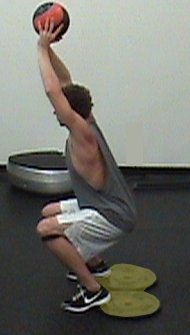Ankle Dorsiflexion:
An athlete who struggles with dorsiflexion will not be able to reach full depth on their squats (as explained here…). You will find that almost without exception, placing a small lift (1 – 1.5 in. tall) under the heel will allow the athlete to easily reach a full parallel squat. This occurs for several reasons:
- If there is some sort of a restriction at the foot, ankle, or lower leg, you will take that out of the squatting equation by putting the foot and ankle in a more neutral position and not asking it to dorsiflex.
- Placing a lift under the heels adjusts the body’s center of gravity, allowing it to utilize a different motor pattern than it is accustomed to for that movement. If you ask an athlete to squat, their body knows that it has a pre-set motor pattern for performing a squat. This pattern may be good or it may be bad, depending upon how cleanly they move. By changing the center of mass of the body, it is forced to use a different motor pattern. This is your opportunity to create a cleaner, more desirable movement pattern. By doing this, you can effectively get around a dorsiflexion restriction which is caused by poor motor firing patterns.
At the end of the day, for many sports medicine professionals, it doesn’t really matter why the lift works, but that it works and works consistently for improving a poor squat. But, it is a heel lift a good long term solution?
While modifications can help change the mechanics, it isn’t a good long term solution. It isn’t a good solution because when you use a lift you aren’t actually making a change to the body. You are simply working around it’s short comings. Also, using a lift makes a squat more quad dominant. Because of the association between ACL tears and quad dominance, we don’t want to cement that movement pattern long term.
So, what is a good long term solution? Using a lift as a tool to correct the restriction. The best way to do this is by starting with a lift which is big enough to make the improvements that you want to see in their overall movement pattern. Usually a 1.5 in. lift is more than enough (the thickness of a 2 x 4). Many weight plates are similar in thickness.
Once they begin to adjust to a deep squat with a heel lift (usually about 2 weeks of training), then begin to take it away. If they started with a 25 pound plate under their heels, move to a 10 pound plate for another 2 weeks. Then continue the progression to a 5 pound plate, then a 2 1/2 and finally no plate. By following this progression and athlete will slowly progress to a deep squat with their feet flat in about 6-8 weeks.
If their restriction is due to a joint restriction, repetitive squatting which challenges their dorsiflexion acts as a self joint mob to correct their restriction. If their problem is related to poor firing patterns, the athlete will slowely and progressively adjust their motor patterns to a more desireable pattern.
Lunge modifications work in much the same way as squat modifications, making changes over times. With lunges, though, you want to use a forefoot lift instead of a heel lift. And, keep in mind that a forefoot lift should be much smaller (no more than 1 in. thick).
With a lunge, an athlete can usually control the amount of dorsiflexion by how far the front foot is placed in front of them. The further out the foot, the less restriction needed to perform a deep lunge.
To correct a restriction, find a comfortable lunge position and place a lift under their front forefoot. As the athlete drops into a deep lunge, they will be forced improve their dorsiflexion with every repetition.
Depending upon the degree of dorsiflexion restriction, you may need to start with a very small lift and increase it over time. The other difference between this and a squat heel lift, is that you don’t have to worry about the same long term issues related to the heel lift. Because you are simply performing a self mob, you don’t need to worry nearly as much about changing firing patterns or cementing a bad motor program.
Looking for more help? Schedule a consultation today!
Back to Dorsiflexion SolutionsBack to Ankle Dorsiflexion
Back to Injury Rehabilitation
Back to Home




Leave a Reply